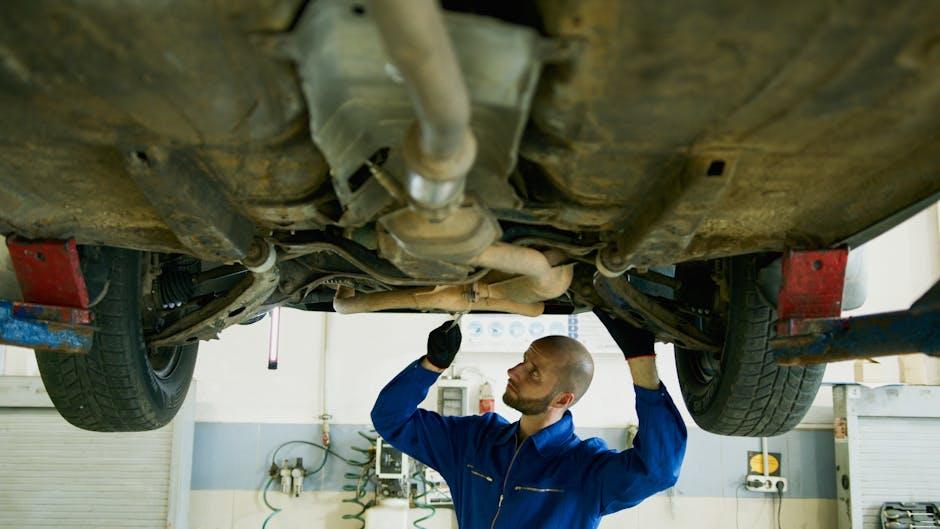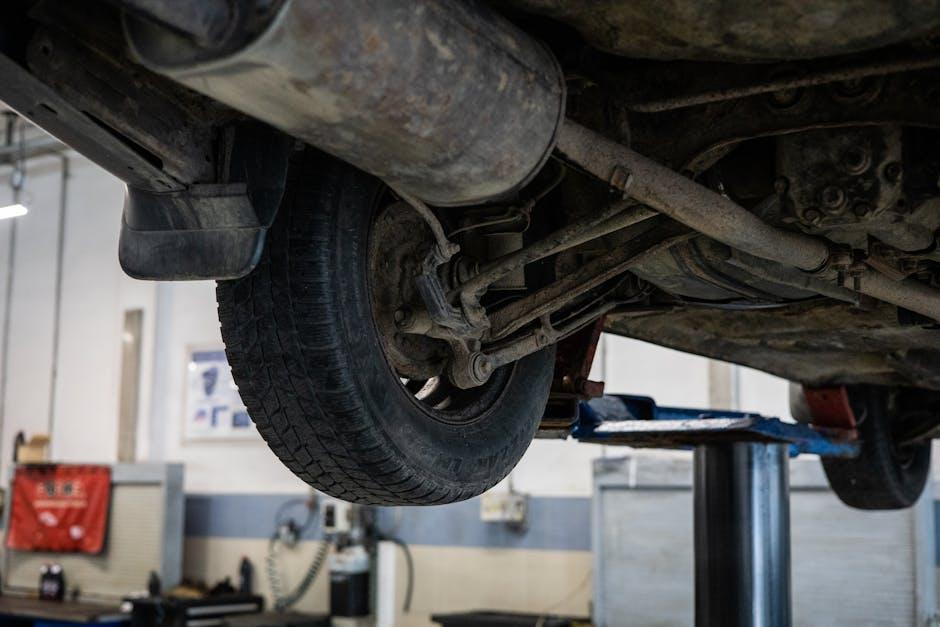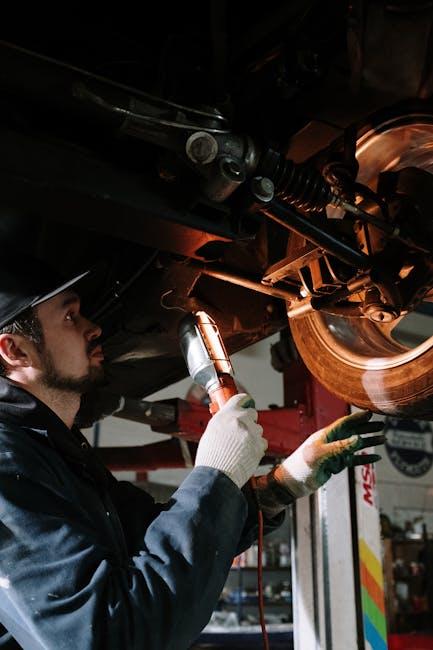When was the last time you truly thought about your vehicle’s suspension? Often overlooked, the suspension system is the unsung hero of every smooth ride, quietly absorbing bumps, stabilizing turns, and ensuring comfort beneath every journey. Just like the foundation of a sturdy building, a well-maintained suspension keeps your car balanced and safe on the road. In this article, we’ll delve into practical suspension maintenance tips that not only extend the life of your vehicle but also transform every drive into a seamless experience. Whether you’re a seasoned gearhead or a casual driver, understanding how to care for your suspension can make all the difference.
Table of Contents
- Understanding the Importance of Suspension Health
- Identifying Early Signs of Suspension Wear
- Essential Tools for Effective Suspension Inspection
- Step by Step Guide to Cleaning Suspension Components
- Choosing the Right Lubricants for Suspension Parts
- When to Replace Suspension Bushings and Shocks
- Q&A
- Final Thoughts

Understanding the Importance of Suspension Health
Maintaining optimal suspension health is crucial not only for a smooth ride but also for your vehicle’s overall safety and performance. The suspension system absorbs shocks from the road, ensuring stability and control during acceleration, braking, and cornering. Neglecting it can lead to uneven tire wear, diminished handling, and increased stress on other vehicle components. Regular checks allow you to catch early signs of wear such as leaking shocks, strange noises, or steering issues, preventing costly repairs down the line.
Understanding the key elements of suspension care can help you extend its lifespan and enhance driving comfort. Simple actions like inspecting bushings, lubricating moving parts, and keeping tires balanced work wonders. Consider this quick checklist to keep your suspension in top shape:
- Visual inspection for damaged or worn components
- Checking alignment and tire condition
- Monitoring ride quality and noise levels
- Scheduling professional suspension audits periodically
| Component | Common Issue | Recommended Action |
|---|---|---|
| Shock Absorbers | Leaking fluid, reduced dampening | Replace every 50,000 miles or as needed |
| Control Arms | Worn bushings causing play | Inspect twice a year, replace bushings if cracked |
| Springs | Sagging or broken coils | Replace immediately for safety |

Identifying Early Signs of Suspension Wear
Recognizing the early whispers of suspension wear can save you both time and money. Pay close attention to unusual sounds like clunking, squeaking, or rattling when driving over bumps or potholes. These noises often indicate worn bushings or loose components. Another subtle hint is the feeling of excessive bouncing or a “floaty” sensation during cornering, which signals that your shocks or struts may no longer be performing optimally. Regularly inspect your tires for uneven wear patterns, such as cupping or bald patches, as these can be a direct consequence of failing suspension parts affecting alignment and stability.
To keep your suspension in check, be mindful of these warning signs and perform visual checks every few months. Look for visible damage like cracked rubber boots, leaking fluid from shock absorbers, or sagging springs. The table below summarizes some common early symptoms and their likely causes, helping you pinpoint issues before they escalate:
| Symptom | Possible Cause |
|---|---|
| Clunking noise over bumps | Worn bushings or ball joints |
| Uneven tire wear | Misaligned or damaged suspension |
| Vehicle bounces excessively | Worn shocks or struts |
| Leaning to one side | Broken or sagging spring |

Essential Tools for Effective Suspension Inspection
When it comes to inspecting your vehicle’s suspension, having the right equipment is crucial for an accurate assessment. Start with a high-quality jack and jack stands to safely lift and support your car, ensuring you can access all suspension components without risk. A flashlight or inspection lamp is indispensable for spotting leaks, cracks, or worn-out bushings in dim areas. Additionally, a tire pressure gauge helps verify that uneven tire wear isn’t a direct symptom of suspension problems, while a mechanic’s creeper can make under-car inspections far more comfortable.
To further streamline your inspection, equip yourself with these handy tools:
- Digital Torque Wrench – Ensures bolts are tightened to manufacturer specifications.
- Dial Indicator – Measures suspension travel and backlash.
- Multimeter – Detects electrical issues if your suspension system involves electronic components.
- Rubber Mallet – Useful for gently freeing seized components without damage.
| Tool | Purpose | Pro Tip |
|---|---|---|
| Jack & Jack Stands | Lift and secure vehicle | Always use on a flat, stable surface |
| Inspection Light | Illuminate dark suspension areas | Choose LED lamps for battery efficiency |
| Torque Wrench | Accurate bolt tightening | Calibrate regularly for precision |

Step by Step Guide to Cleaning Suspension Components
Start by safely lifting your vehicle and removing the wheels to gain clear access to the suspension components. Use a gentle brush or compressed air to clear off loose dirt, ensuring not to damage delicate parts like bushings and seals. For stubborn grime, apply a biodegradable degreaser and let it sit briefly before scrubbing with a soft-bristled brush. Rinse with low-pressure water to avoid dislodging grease seals, and always dry the components thoroughly to prevent rust formation.
When cleaning, focus on:
- Control arms – free from build-up that can affect their movement
- Shock absorbers – wipe down to check for leaks or dents
- Springs – remove dirt without compromising their protective coatings
- Ball joints and bushings – ensure they are free from debris to maintain smooth articulation
| Component | Cleaning Tip | Frequency |
|---|---|---|
| Control Arms | Use mild brush and degreaser | Every 6 months |
| Shock Absorbers | Wipe and inspect for leaks | Every 4 months |
| Springs | Rinse and dry thoroughly | Annually |
| Ball Joints | Remove debris carefully | Every 6 months |

Choosing the Right Lubricants for Suspension Parts
When maintaining your vehicle’s suspension, selecting the appropriate lubricant is crucial to ensure smooth performance and longevity. Suspension systems often encounter extreme conditions—heat, moisture, and heavy loads—that can degrade inferior lubricants. Opt for high-quality, synthetic greases that provide superior resistance to water and oxidation. These offer better adherence to moving parts like bushings and ball joints, reducing friction and wear. Additionally, grease with molybdenum disulfide (moly) additive is highly recommended for metal-on-metal contact areas, as it forms a protective layer, minimizing direct surface abrasion.
Different suspension components require specific lubrication types, so matching the lubricant to each part’s demands is essential. For instance, rubber bushings and seals should be treated with silicone-based lubricants to prevent drying and cracking, whereas lithium-based greases work great for metal joints and bolts due to their water-repellent nature. Here’s a quick guide to help you choose:
| Suspension Part | Recommended Lubricant | Key Benefits |
|---|---|---|
| Ball joints | Synthetic grease with moly | Reduces metal wear, high heat tolerance |
| Rubber bushings | Silicone-based lubricant | Prevents drying, maintains flexibility |
| Shock absorber mounts | Lithium-based grease | Water resistant, durable protection |
| Control arm bolts | Anti-seize compound | Prevents rust and seizing |

When to Replace Suspension Bushings and Shocks
Recognizing the right moment to change your suspension bushings and shocks is crucial for a smooth and safe drive. If you notice clunking noises over bumps, uneven tire wear, or a steering wheel that feels loose or wanders on the road, these are clear signals that your suspension components might be wearing out. Additionally, visible signs such as cracked or deteriorated bushings and oil leakage from shock absorbers often indicate the need for replacement. Don’t wait for a total failure; addressing these issues early can prevent further damage to your vehicle’s suspension system.
Keep an eye out for these common symptoms that suggest it’s time to service or replace suspension parts:
- Excessive bouncing after hitting a bump
- Increased braking distance or nose-diving during stops
- Vehicle pulling to one side while driving
- Vibrations in the steering wheel at higher speeds
| Symptom | Likely Component | Action |
|---|---|---|
| Uneven Tire Wear | Bushings | Inspect & Replace |
| Oil Leak Near Suspension | Shocks | Replace Immediately |
| Excessive Bounce | Shocks | Replace |
| Steering Wheel Play | Bushings | Inspect & Tighten/Replace |
Q&A
Q&A: Suspension Maintenance Tips
Q1: Why is suspension maintenance important for my vehicle?
A1: Your vehicle’s suspension system ensures a smooth ride, improves handling, and maintains tire contact with the road. Proper maintenance helps prevent wear and tear, enhances safety, and extends the lifespan of suspension components.
Q2: How often should I inspect my suspension?
A2: A general rule is to visually inspect your suspension every 12,000 miles or at least once a year. However, if you notice unusual noises, poor handling, or uneven tire wear, it’s wise to check sooner.
Q3: What are common signs that my suspension needs maintenance?
A3: Watch out for excessive bouncing, nose-diving while braking, uneven tire wear, pulling to one side, or strange noises like clunks and squeaks. These symptoms can indicate worn shocks, struts, or other suspension parts.
Q4: Can I maintain my suspension system myself, or do I need a professional?
A4: Basic visual checks and keeping components clean can be done at home, but in-depth inspections, alignments, or part replacements should be performed by professionals to ensure safety and proper handling.
Q5: Does tire pressure affect suspension performance?
A5: Absolutely. Maintaining correct tire pressure reduces stress on suspension parts and ensures optimal contact with the road, contributing to a smoother ride and longer-lasting components.
Q6: Are there any preventative measures to extend suspension life?
A6: Driving carefully over bumps, avoiding potholes, rotating tires regularly, and timely replacing worn parts help preserve your suspension’s health.
Q7: How do climate and road conditions impact suspension maintenance?
A7: Harsh weather and rough roads accelerate wear. Salt, mud, and water can corrode parts, so regular cleaning and inspections are critical if you live in challenging environments.
Q8: What role do shocks and struts play, and when should they be replaced?
A8: Shocks and struts dampen road impacts to prevent excessive bouncing. Replace them every 50,000 to 100,000 miles, or sooner if you experience poor ride quality or handling issues.
Q9: Is an alignment part of suspension maintenance?
A9: Yes. Wheel alignment ensures tires meet the road at the correct angle, improving steering and reducing uneven tire wear. It’s essential after suspension repairs or if you notice steering pull.
Q10: Can suspension upgrades improve performance?
A10: Upgrading to heavy-duty or performance suspension components can enhance handling and comfort, especially for specialized driving needs, but routine maintenance remains key to longevity.
Final Thoughts
Maintaining your suspension system is more than just a routine chore—it’s the silent guardian of your vehicle’s comfort and safety. By keeping these tips in mind and addressing issues early, you’re not only enhancing your ride quality but also extending the life of your car. Remember, a well-maintained suspension ensures every journey feels smooth, controlled, and confident. So, take the time to nurture this crucial component, and your vehicle will thank you miles down the road.

